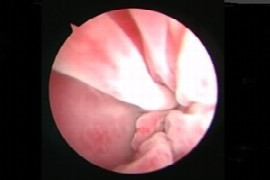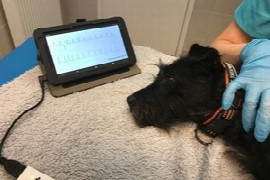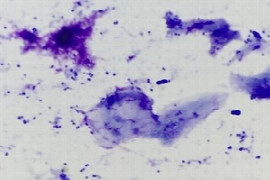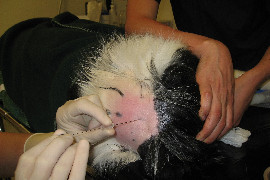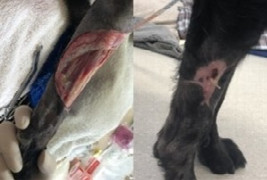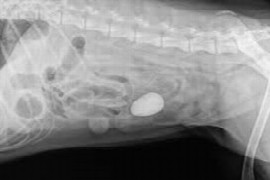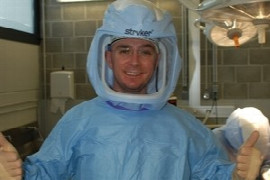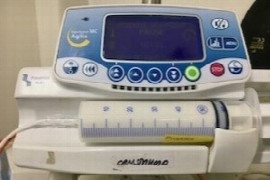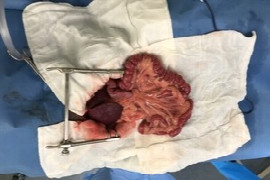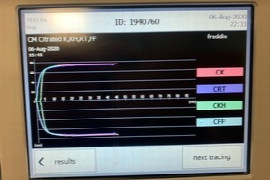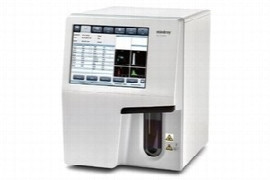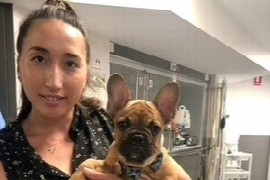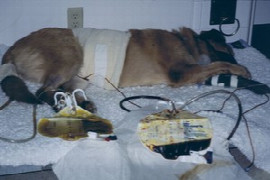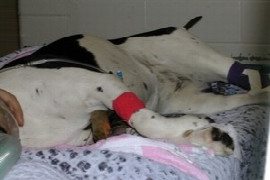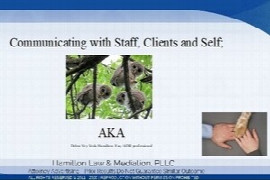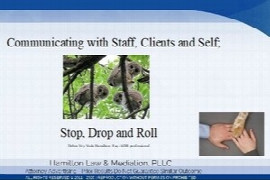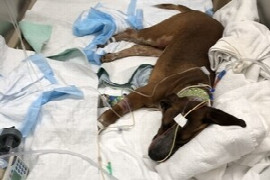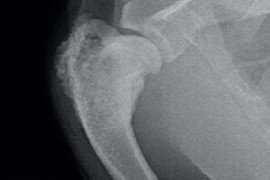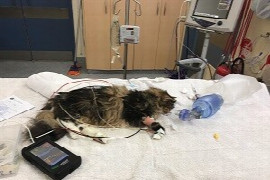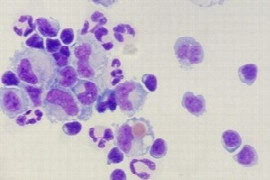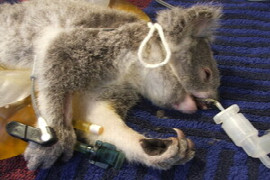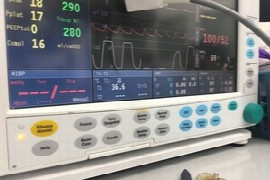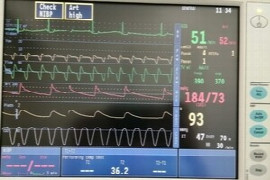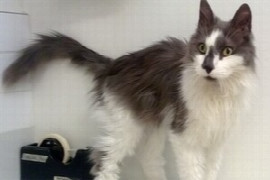Endoscopy of the airways in dogs and cats
During this presentation you will learn how much information you can get from an endoscopy of the airways, the type of samples that can be collected and the treatments that can be done under endoscopic guidance such as airway stenting. Using endoscopic images, you will travel from the nasal...
Duration:
1:00 h
Speaker:
Erika Meler
from 1
US$ 46.20
(incl. tax)
(incl. tax)
Get Rhythm: A Nurse’s Guide to ECG’s
ECG’s can be daunting, it is an area of veterinary nursing that is not taught in great detail and one that is sometimes avoided because it is poorly understood. This webinar will go back to basics; where better to start than at the beginning?
Duration:
1:06 h
Speaker:
Lauren Holland
from 1
US$ 46.20
(incl. tax)
(incl. tax)
Why I love seeing ear infections - crucial tips on diagnostics and treatment
Utilising case studies, this webinar will focus on essential diagnostic and treatment tips that turn around many chronic otitis cases quickly. Optimal use of diagnostic tests will be discussed, including techniques and indications for otoscopic exam, cytology, and culture and sensitivity testing, and their relative importance for guiding selection of effective treatment plans...
Duration:
1:13 h
Speaker:
Linda Vogelnest
from 1
US$ 46.20
(incl. tax)
(incl. tax)
The WHO 5 moments of hand hygiene: a concept applicable in veterinary medicine (for Nurses)
Over the past few decades, the World Health Organisation (WHO) has put increased focus on hand hygiene campaigns under the slogan “Clean Hands – Save Lives” following the global recognition of hand hygiene being a key factor in reducing surgical site (SSI) and other hospital associated infections (HAIs)...
Duration:
0:58 h
Speaker:
Denis Verwilghen
from 1
US$ 46.20
(incl. tax)
(incl. tax)
What do I need to know about meningitis in dogs
The term meningitis is commonly recognised in human medicine as an extremely aggressive, rapidly progressive fatal condition, most commonly seen in children. In humans, it is generally associated with infectious causes, bacterial or viral. In dogs..
Duration:
0:51 h
Speaker:
Rita Goncalves
from 1
US$ 46.20
(incl. tax)
(incl. tax)
Common Malignancies of the Skin - Mast Cell Tumors and Soft Tissue Sarcomas in Dogs and Cats
Tumors of the skin and subcutaneous tissues are the most common malignancies in dogs and cats accounting for over 30-40% of tumors in dogs and 29% in cats...
Duration:
0:51 h
Speaker:
Stephanie Colthurst
from 1
US$ 46.20
(incl. tax)
(incl. tax)
Diagnosing a Foreign Body
A discussion that shows the vital radiographic signs to look out for when deciding if a foreign body is present and whether to cut or not to cut. This will include real world case studies to help reinforce the teaching points.
Duration:
0:43 h
Speaker:
Catheryn Walsh
from 1
US$ 46.20
(incl. tax)
(incl. tax)
Prevention of Surgical Site Infection for Nurses
Surgical site infections (SSI) are the burden of surgery. They lead to increased health care cost due to additional treatment, antibiotics, hospital stay and excess death. Further, these complications create emotional and financial distress for owners and drastically affect the animal’s welfare...
Duration:
0:57 h
Speaker:
Denis Verwilghen
from 1
US$ 46.20
(incl. tax)
(incl. tax)
Acute Respiratory Distress Syndrome (for Nurses)
Acute Respiratory Distress Syndrome is defined as an acute, diffuse, inflammatory lung condition leading to significant changes in a patient’s lung tissues, ability to oxygenate and ability to breath. It is the most severe form of Acute Lung Injury (ALI) and is often fatal with very few effective modalities in human medicine let alone veterinary medicine...
Duration:
0:47 h
Speaker:
Cheryl MacPherson
from 1
US$ 46.20
(incl. tax)
(incl. tax)
Tips on where to start with vet practice marketing
If the mere mention of the word marketing instils fear into your heart and you don't know where to start when it comes to implementing a marketing and communications plan for your veterinary practice, Phil's webinar will provide tips on where to start with veterinary practice marketing...
Duration:
0:39 h
Speaker:
Phil Tucak
from 1
US$ 46.20
(incl. tax)
(incl. tax)
Understanding rescue pet behaviour in the clinic setting
Rescue pets can present as challenging in the clinic setting with many displaying fear, anxiety and aggression towards staff. These behaviours can make routine exams and procedures difficult and stressful for staff, pet owners and pets alike...
Duration:
0:42 h
Speaker:
Kate Mornement
from 1
US$ 46.20
(incl. tax)
(incl. tax)
Total intravenous anaesthesia TIVA - when and how - for Nurses
Total intravenous anaesthesia (TIVA) involves the maintenance of general anaesthesia using only injectable anaesthetic drugs, rather than the more traditional practice of using inhalant agents. In some situations, such as work in remote areas, this technique is of a practical advantage. In other cases, for example, severe neurological disease or during some respiratory procedures, TIVA is a safer option compared to inhalational anaesthesia...
Duration:
0:54 h
Speaker:
Jennifer Davis
from 1
US$ 46.20
(incl. tax)
(incl. tax)
Its an intestinal foreign body, now what? Tips for approaching gastrointestinal surgery with confidence
Gastrointestinal foreign bodies can be some of the most rewarding surgical emergency cases, but the potential for serious complications can make these cases daunting! In this webinar, we will discuss surgical techniques for foreign body retrieval at each level of the GI tract (gastrotomy, enterotomy, intestinal resection-anastomosis), as well as some practical tips for managing linear foreign bodies in dogs and cats...
Duration:
0:55 h
Speaker:
Bronwyn Fullagar
from 1
US$ 46.20
(incl. tax)
(incl. tax)
Defining Point of Care Ultrasound - POCUS in everyday practice
This lecture will cover the key concepts regarding point of care ultrasound including the definition and evolution of the FAST exam to Veterinary Point of Care Ultrasound (VPOCUS), how VPOCUS differs from consultative ultrasound exams, the key formats currently used, when and where VPOCUS should be applied, patient positioning, and the value of using clinically relevant binary questions.
Duration:
0:55 h
Speaker:
Serge Chalhoub, Soren Boysen
from 1
US$ 46.20
(incl. tax)
(incl. tax)
Disseminated intravascular coagulation
Disseminated Intravascular coagulation (DIC) is an uncommon but complex disease process with a high mortality. Paramount to success is early detection and invention...
Duration:
0:48 h
Speaker:
Kerry Doolin
from 1
US$ 46.20
(incl. tax)
(incl. tax)
Snake envenomation in Australia: The current state of play
Snake envenomation is a common reason for presentation of dogs and cats to Australian veterinary clinics, yet diagnosis and treatment continue to be challenging in some cases. Fortunately there has been an explosion of veterinary research in recent years, providing us with more evidence than ever to guide our patient management.
Duration:
1:03 h
Speaker:
Claire Sharp
from 1
US$ 46.20
(incl. tax)
(incl. tax)
Quality management for your in-clinic laboratory
Quality management for your in-clinic laboratory’ may not sound like a particularly fun webinar topic; however, if you rely on blood test results from an in-clinic laboratory to make medical decisions, then this webinar is not to be missed!...
Duration:
1:02 h
Speaker:
Bradley Galgut
from 1
US$ 46.20
(incl. tax)
(incl. tax)
Surgical options for Brachycephalic Airway Syndrome
As brachycephalic breeds continue to increase in popularity, the diagnosis and treatment of brachycephalic airway syndrome (BAS) is ever important in improving the quality of life of these animals. This presentation will cover surgery for BAS including treatment of stenotic nares, redundant/elongated soft palate, laryngeal saccule eversion and laryngeal collapse.
Duration:
0:48 h
Speaker:
Stephanie Colthurst
from 1
US$ 46.20
(incl. tax)
(incl. tax)
Monitoring the Recovering Ill or Injured Patient: Key Points (for Nurses)
The team approach is stressed. Orders are outlined and some highlighted for discussion. Vital signs and further testing, quick assessment tests (QATs), fluid therapy, ongoing fluid losses from head to toe, nutritional support, assessing for systemic illness, tips for post-surgical observations and pain management.
Duration:
0:46 h
Speaker:
Karol Mathews
from 1
US$ 46.20
(incl. tax)
(incl. tax)
Transfusion Medicine – not just for the faint hearted (for Nurses)
We give blood products on an increasingly frequency in veterinary medicine, but how much do we really know about the product we are giving, the indications for each product and possible sequelae to this administration of foreign products? Blood and blood products are foreign to our patients, and each time we give them we have to weigh up the risks vs the benefits to our patients...
Duration:
0:51 h
Speaker:
Samantha Livingstone
from 1
US$ 46.20
(incl. tax)
(incl. tax)
Maintaining welfare standards during hospitalisation
Have you ever wondered if you are ‘doing enough’ for your patients when they are hospitalised with you? Are you a ‘let’s get the job done as quickly as possible so it’s over for the animal’ type person or more of a ‘I want to try and make this as postive as possible for the patient’ type person?
Duration:
0:58 h
Speaker:
Hayley Walters
from 1
US$ 46.20
(incl. tax)
(incl. tax)
Addison’s - make your patients thrive, not just survive
Most veterinarians have diagnosed and managed dogs with Addison’s; but did you know that >90% of us are not maximising the quality of life and longevity of this patient population? Did you know that prednisolone is one of the worst drugs to use for supplementation? Did you know that DOCP starting dosages are too high in >90% of patients?...
Duration:
1:03 h
Speaker:
Stijn Niessen
from 1
US$ 46.20
(incl. tax)
(incl. tax)
Physical and Chemical Restraint in the Emergency Room (for Nurses)
Injured, and many ill patients, are painful sometimes it is obvious but others not. History and physical examination upon admission must include assessment, severity and location of pain to avoid these areas during restraint. Extreme caution with a penetrating foreign body is presented. Various procedures are required to treat and diagnose patients presenting on an emergency basis.
Duration:
0:50 h
Speaker:
Karol Mathews
from 1
US$ 46.20
(incl. tax)
(incl. tax)
Toxicology – Treatment and management of paracetamol and recreational drugs
Ingestion of human medications and recreational drugs is a common occurrence in small animal practice. There are myriad clinical presentations of toxicosis. This webinar will cover some of the most common clinical syndromes. This includes tips on when to suspect toxicosis is a likely differential diagnosis.
Duration:
0:58 h
Speaker:
Corrin Boyd
from 1
US$ 46.20
(incl. tax)
(incl. tax)
Communicating with the Client, Staff and Self - AKA
Addressing disagreements, deciding whether you will keep the staff/client and appreciating alternate points of view are difficult skills to learn. The strategies you will learn in this program will help you be more curious and ask questions that are meant to gather more information. This is often called appreciative inquiry (AI)...
Duration:
1:07 h
Speaker:
Debra Vey Voda-Hamilton
from 1
US$ 46.20
(incl. tax)
(incl. tax)
Communicating with the Clients, Staff and Self - Stop Drop and Roll
Keeping your cool and needing to right at the same time is not easy. The conflict management method taught here not only helps save veterinary business culture [and sanity] it does so in less time and for less expense then a reactive and defensive position. This program will provide you with the skills to maintain your own peace of mind while providing tools and skills that will foster collaborative discussions among alternate points of view.
Duration:
0:51 h
Speaker:
Debra Vey Voda-Hamilton
from 1
US$ 46.20
(incl. tax)
(incl. tax)
Obesity in Dogs
Obesity is recognized as the most important medical disease in pets worldwide with a prevalence of 40-60 %. It not only increases disease risk, it reduces quality of life and shortens life expectancy. In this webinar, we will discuss different weight loss regimens (include examples) and life style adaptations (like treats), ways to improve owner compliance and pitfalls to avoid.
Duration:
0:51 h
Speaker:
Stefanie Handl
from 1
US$ 46.20
(incl. tax)
(incl. tax)
Preparing the Critical Patient for Surgery (for Nurses)
Emergency surgery is just that – an emergency – and often needs to happen as soon as possible. But immediate anesthesia should not be an excuse for not preparing the patient or the nursing team, it’s even more reason to prepare! This lecture will cover the important body systems and abnormalities that must be treated and assessed prior to emergency anesthesia to ensure a smooth procedure and successful patient recovery. An emphasis is placed on critical thinking skills and teamwork.
Duration:
0:52 h
Speaker:
Megan Brashear
from 1
US$ 46.20
(incl. tax)
(incl. tax)
I think the dog has bone cancer. What's next?
A dog presents to you limping. You take an x-ray and discover an aggressive bone lesion. You suspect a primary bone tumour. What are the differential diagnoses? What next?
As a vet, you will encounter a dog with an aggressive appendicular bone lesion on x-rays. Most dogs will have osteosarcoma, but other types of cancers, benign lesions and infection are possible.
Duration:
0:56 h
Speaker:
Catherine Chan
from 1
US$ 46.20
(incl. tax)
(incl. tax)
Shock – what is it, how is it treated and what do I monitor (for Nurses)
All about Shock A patient presents in “Shock” – what does this actually mean? What is happening to that patient and how can we best treat this critical condition? There are 3 different types of shock - hypovolaemic, distributive and cardiogenic, this webinar will explain what these terms mean and how you can differentiate between the different forms of shock...
Duration:
0:46 h
Speaker:
Skye Carr
from 1
US$ 46.20
(incl. tax)
(incl. tax)
Juggling the Triad of Care at End of Life The Patient The Client and The Care Team
Supporting clients with a pet approaching the end of life can be challenging for everyone. Learning to recognise what your clients need and how to best deliver it as part of a wider inter-disciplinary team, is often critical to the success of a patient care plan.
Duration:
0:47 h
Speaker:
Jackie Campbell
from 1
US$ 46.20
(incl. tax)
(incl. tax)
Emergency Medicine in Rabbits
Emergency and critical care of rabbits is a new concept and an exciting challenge. At presentation, prey species like rabbits may disguise obvious clinical signs making triage more complicated. However most emergency and critical care techniques used in other companion animals can be applied, and familiarity with common rabbit presentations can improve the management of these pets. Ileus, dyspnoea and seizure are examples of possible conditions that, with the right approach, can be treated successfully. Anorexia is also a very common emergency that should be treated within 24-48 hours from presentation. However, anorexia is a clinical sign and not a disease, and the cause should be thoroughly investigated and treated. This webinar will describe the emergency equipment advised for the rabbit patient and some of the most common emergency presentations and their treatments.
Duration:
1:02 h
Speaker:
Livia Benato
from 1
US$ 46.20
(incl. tax)
(incl. tax)
CSF evaluation - Cytology and Infectious Disease Diagnostics (for Nurses)
Evaluation of CSF is an important diagnostic tool for assessment of patients displaying neurological abnormalities. Basic cytological evaluation of CSF includes determination of the total and differential leukocyte counts and protein concentration.
Duration:
0:53 h
Speaker:
Leanne Twomey
from 1
US$ 46.20
(incl. tax)
(incl. tax)
Managing Busy Shifts without Burnout (for Nurses)
Have you been asked to do shift work but feel leery about the rumours of the many challenges that come with it? Or are you a seasoned shift worker feeling like this gruelling schedule is catching up with you as each shift is filled with increasing errors, brain fog, exhaustion, overwhelm - and even weight gain?
Duration:
0:54 h
Speaker:
Dori martin
from 1
US$ 46.20
(incl. tax)
(incl. tax)
Snots and Snuffles: Feline Upper Respiratory Disease
Upper respiratory tract disease is not uncommon in cats, chronic snuffles can be frustrating to manage, and laryngeal disease can be an acute emergency. This webinar will discuss infectious and non-infectious conditions of the upper airway, with practical treatment suggestions and case examples.
Duration:
0:59 h
Speaker:
Samantha Taylor
from 1
US$ 46.20
(incl. tax)
(incl. tax)
Updates in Perioperative Fluid Therapy
Provision of fluid therapy is an important aspect of patient support during anaesthesia. In recent years there have been various guidelines published regarding perioperative fluids in veterinary medicine. However, there are many factors to consider when creating an individualised fluid plan for small animals undergoing anaesthesia. This webinar will guide you through a logical approach to incorporating new information on this topic into your everyday clinical practice. The webinar will cover: indications for the provision of perioperative fluids, choice of fluid type and rate of administration for a range of patients, monitoring changes to fluid requirements during anaesthesia, and potential adverse effects of inappropriate fluid therapy.
Duration:
0:55 h
Speaker:
Jennifer Davis
from 1
US$ 46.20
(incl. tax)
(incl. tax)
Feline Pain Management
Recognising and treating pain can be challenging and particularly so in our feline patients. In this webinar we will look at the importance of recognising and measuring pain and explore the tools available to assess acute pain in cats such as the recently developed grimace scale. We will also review analgesic options and techniques available to treat perioperative pain in our feline patients.
Duration:
0:47 h
Speaker:
Eleanor Holden
from 1
US$ 46.20
(incl. tax)
(incl. tax)
Analgesia and Anaesthesia in Exotic Companion Mammals
As rabbits, guinea pigs, ferrets and rats become increasingly popular pets with close bonds to their owners, these animals are more likely to present to veterinary clinics for routine and urgent care. Collectively known as Exotic Companion Mammals (ECM), the unique anatomy...
Duration:
1:00 h
Speaker:
Jaclyn Gatt
from 1
US$ 46.20
(incl. tax)
(incl. tax)
The clinical approach to paraplegia in dogs
Myelopathies resulting in paraparesis/paraplegia in dogs and cats are commonly encountered in clinical practice. This lecture reviews the clinical and diagnostic approach the dogs presented with paraparesis/paraplegia in describes pathophysiology, clinical presentation, diagnosis, treatment, outcome and prognosis of specific disorders.
Duration:
1:08 h
Speaker:
Elsa Beltran
from 1
US$ 46.20
(incl. tax)
(incl. tax)
Let’s talk cat and dog behaviour at 2nd vac (and put some myths to bed)
The dreaded end of consult question…. “Can I just ask you quickly? Why does my cat spray urine in my kitchen”? Or “How can I stop my dog chewing the sofa when I go out?” These questions, although common place, can often be difficult to answer. But what if we worked towards the owner never having to ask them in the first place?
Fence at the top of the cliff or an ambulance at the bottom?
We can help to prevent common problems from developing by recognising that we are well placed to educate owners during the second vaccination appointment on how to foster emotional resilience in their dog or cat. In other words, if they put the work in at the beginning, then the chance of a behavioural problem developing reduces. Let’s talk about more than worming, nutrition and neutering!
This webinar aims to look at:
• Understanding what motivates cats and dogs and how we reinforce their behaviour – good and bad
• Advising owners on how good intentions early on will lead to good welfare outcomes in a variety of common behavioural challenges
• Recognising the communication and body language that often precedes a dog bite – it’s not about dominance!
Duration:
1:00 h
Speaker:
Hayley Walters
from 1
US$ 46.20
(incl. tax)
(incl. tax)
Is it just an innocent murmur? Congenital Heart Disease in Puppies and Kittens & Cats (for Nurses)
Heart murmurs in young puppies and kittens are often managed incorrectly. We know that a delay in the diagnosis of congenital heart disease can mean incorrect treatments and cause a major impact on longer term prognosis. This webinar will help guide the veterinary team through the assessment, management and prognosis of commonly encountered congenital heart diseases with plenty of practical tips and tricks for improving your knowledge on the subject. It also aims to give delegates confidence when discussing these congenital conditions with owners and colleagues.
Learning Objectives:
• How to identify animals that may have congenital heart disease
• Understand the most appropriate tests and how to perform these well in young animals
• Improve ability to detect and understand the significance of a murmur
• Prognosis and treatment options available for the common congenital heart conditions seen
Duration:
0:57 h
Speaker:
Chris Linney
from 1
US$ 46.20
(incl. tax)
(incl. tax)
Nursing Wildlife - First Aid
Want to know what to do with a fractured wing? Or a possum who came off second best with a cat? What about those car hit koalas which are guaranteed to unsettle even the calmest nurse…..
This seminar will broadly cover first aid principles as they apply to our native wildlife. Building on your domestic animal First aid knowledge and bending it to appropriate measures for wildlife. We will discuss fluid support, analgesia, and triage for incoming wildlife, as well as broad guidelines for decision making when it comes to euthanasia, in clinic treatment, or referral on to wildlife specialist practices. Lead by Dr Robyn Stenner, with over 10 years’ experience as a wildlife veterinarian, this seminar will be packed full of simple yet effective and time saving points to help you and the clinic more confidently care for wildlife.
Duration:
1:04 h
Speaker:
Robyn Stenner
from 1
US$ 46.20
(incl. tax)
(incl. tax)
Feline Nutrition, A Clinicians Perspective
What should we feed cats? Raw meaty bones vs commercial “complete and balanced” diets? Commercial cat food has resulted in decreased in hypervitaminosis A, thiamine deficiency and secondary nutritional hyperparathyroidism. But should this be used as evidence that alternative diets based on ancestral diets should not be used when none of these cited conditions would occur with an ancestral diet? In addition, it is easy to assess improvement in known straightforward dietary-related conditions but far more difficult to detect increased or decreased incidence of medical diseases where the contribution of diet is more subtle. Any improvement in medical diseases due to commercial diets needs to be balanced against the emergence of potential adverse conditions but this data is rarely present. We hear from nutritionists but not clinicians. This unique lecture is given from a feline medicine specialist’s perspective.
Duration:
1:05 h
Speaker:
Sue Foster
from 1
US$ 46.20
(incl. tax)
(incl. tax)
Principles of Ventilation for Nurses
This webinar will cover the following topics:
• Which patients to ventilate, how to start ventilation and wean from the ventilator
• Basic settings for ventilators
• How to troubleshoot common problems
Duration:
0:37 h
Speaker:
Karla Borland
from 1
US$ 46.20
(incl. tax)
(incl. tax)
Nursing the Vestibular Patient
Can you imagine waking up one day feeling like the world is unexpectedly spinning out of control and suddenly you can’t stand up straight let alone walk a few steps? You feel nauseous, unbalanced and scared. This is how our vestibular disease patients find...
Duration:
0:38 h
Speaker:
Skye Carr
from 1
US$ 46.20
(incl. tax)
(incl. tax)
Advanced Mechanical Ventilation
This webinar will try and cover the current employed strategies and predictors for an optimised outcome of the mechanically ventilated patients based on the current evidence from human and veterinary medicine.
Duration:
1:06 h
Speaker:
Manuela Pascal
from 1
US$ 46.20
(incl. tax)
(incl. tax)
Basics of Obstetrics
Requests for veterinary obstetrical assistance are becoming more common for clinicians in private practice and cases of dystocia are frequently encountered in emergency clinical settings. The emotional and financial value of stud dogs, breeding bitches and their offspring makes the preventable loss of even one neonate undesirable. It is therefore important for veterinarians to understand the whelping process and the basics of obstetrics.
Duration:
1:05 h
Speaker:
Nadine Apteker
from 1
US$ 46.20
(incl. tax)
(incl. tax)
The Hyperthyroid Cat
Originally recognised approximately 40 years ago, hyperthyroidism is the most common feline endocrinopathy. How has our understanding of this common disease of cats and it’s management changed since then? This webinar will revisit the diagnostic approach, management options, complications and currently recommended monitoring for these patients. Which medical treatment option is best and why? How often does iatrogenic hypothyroidism occur and how can we diagnose and treat this in cats? What are the renal implications of thyroid disease in cats and how can we best assess and monitor this in these patients? Update and refresh your knowledge of this common feline disease.
Duration:
0:59 h
Speaker:
Lara Boland
from 1
US$ 46.20
(incl. tax)
(incl. tax)
